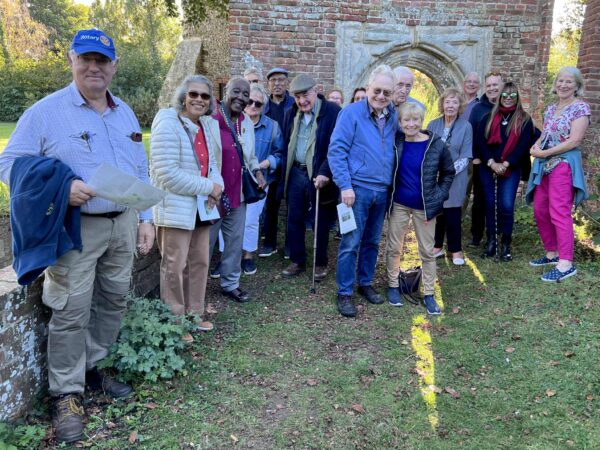We enjoyed a fascinating visit to the Franciscan Gardens in Canterbury on Tuesday, described by some as the City’s “secret jewel”. Nestled by the River Stour, these two acres hold centuries of history, from their origins with the first Franciscan friars who arrived in the 13th century, through dramatic changes at the time of Henry VIII, to their current role as a lovingly restored heritage garden.

While many of the group had never visited the gardens – despite living in Canterbury for decades – we had of course heard much about them from a talk given by gardeners Robert and Tracey Jones when they came to speak to us during the garden’s refurbishment period.
The story of the Franciscans in Canterbury begins when nine friars were sent by St Francis himself to preach the gospel and assist the poor. Over the next 300 years they built a thriving friary, including a great church completed in 1325. Today, the only part of that complex to survive is the chapel, possibly spared because it stood by a crossing point on the river. This small building has served many roles over the centuries, from warden’s house to jail, and still bears traces of “graffiti” left by prisoners awaiting transportation.
Following the dissolution of the monasteries, the site passed to the Lovelace family in 1536. The only visible remnant of their time is the manor wall, which still stands alongside a Victorian vinery that volunteers now hope to restore. Later owners used the land for grazing and market gardening, reducing the friary grounds from 19 acres to just two. The cathedral acquired the site in 1958, before transferring it to Eastbridge Hospital, who reopened it in 2019 as a heritage garden, redesigned by garden designer Sarah Morgan.
Today the gardens are run almost entirely by volunteers. Our guide described how the volunteers work organically, using hand tools as much as possible, composting their own green waste and maintaining the garden’s historic character. Visitors can see a cutting garden in the medieval tradition, where every plant has a purpose (e.g. herbs, or for dyeing fabrics), as well as heritage fruit trees planted in a new orchard, a meditation area, and wildflower meadows that were described as “stunning” in summer. “Come again in different seasons,” our guide said.
Highlights of our tour included the Lovelace wall, now swathed in wisteria, the bridge that spans both Roman and Victorian construction, and the chalk scree banks – a rare ecological feature, with only 2% of the world’s distribution of chalk scree found in Kent. We also admired dahlias named after bishops, and learned that trees such as quince, medlar and mulberry, which would once have been familiar sights in the friary gardens, have been planted there.
The Franciscan story itself is striking. Unlike monasteries, which were largely inward-looking, friaries were outward facing, supporting the needy in the local area. It was interesting to learn that the friars were accused of being vagabonds and thieves on arrival in Dover – one friar was so upset at this that he even offered his rope for hanging if people truly believed that’s what they were.
We all had a gentle wander around the garden in the early autumn sunlight, enjoying looking at the plants, the scenery and even exploring the chapel (where we spotted an old map of Canterbury as well as the “graffiti”).
The serene little garden, steeped in history, was a pleasant place to spend some time together. After our visit a few Rotarians and heir partners enjoyed dinner at a local restaurant before heading home, musing on how Rotarians and the friars had much in common in their work to help the local community.
You can read about the gardens and find out how to support them on their website, here.
Picture: Some of our members, partners and guests pose for a picture during the visit. Picture credit: Rotary Club of Canterbury. More pictures will be shared on our Facebook page soon.


